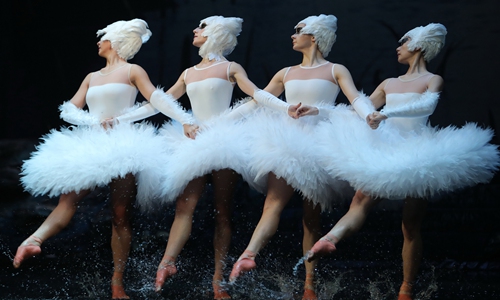HOME >> ARTS
For ballet shoes, one Russian company is on pointe
Source:AFP Published: 2020/3/1 13:13:22

A group of ballet dancers Photo: IC
Craftsman Sergei Murza runs his fingers over a pointe shoe he has just finished making. Then he gives it the final test: The ballet slipper balances perfectly on its tip.
Murza produces the shoes in the Moscow workshop of Grishko, a company born in the chaos of the collapse of the former Soviet Union and now one of the world's top makers of ballet pointe shoes.
In a country better known for exporting oil and arms, Grishko is a rare success story for Russian craftmanship, its shoes sold around the globe and gracing the stages of the world's top ballet venues.
It's hardly surprising, founder Nikolay Grishko says, given the aura that surrounds Russia's storied ballet tradition.
"It is in Russia that classical ballet has reached its highest level," says the 71-year-old, who founded the company more than 30 years ago and continues to run it.
Grishko has diversified into clothing and other dance shoes, but the ballet line is the company's heart and soul.
Nearly 80 percent of its production is for export, with the US and Japan the top buyers.
Inspired by the liberalization of the Soviet Union under Mikhail Gorbachev, Grishko set up the company in 1988.
A former diplomat posted in Laos and economics professor, he found inspiration close to home.
"My wife was a dancer... I already knew what pointes were," he says in his office at the factory, dapper in a dark suit and black-rimmed glasses.
When he launched the business, Russia's big theaters had their own in-house workshops making pointes. That tradition is now gone, but the expertise built up over centuries lives on in his company.
"I took the best of the tradition of Russian pointes, which have been made since the end of the 19th century. This tradition was passed on in the theater workshops but practically disappeared after the fall of the Soviet Union in 1991, says the Ukrainian-born Grishko.
Today he employs more than 500 people at workshops in Moscow, the Czech Republic and Macedonia. In Russia, a pair of Grishko pointes sells for the equivalent of 30 euros ($33), in western Europe about twice that.
Star dancers can go through up to 30 pairs a month, but professionals account for only 10 percent of Grishko's buyers. Most sales go to ballet schools.
Grishko says he is even seeing a new kind of client: women who, tired of "boring aerobic exercises" and treadmills, are taking up ballet to keep fit.
Newspaper headline: The perfect fit
Posted in: DANCE,CULTURE & LEISURE,ARTS FOCUS